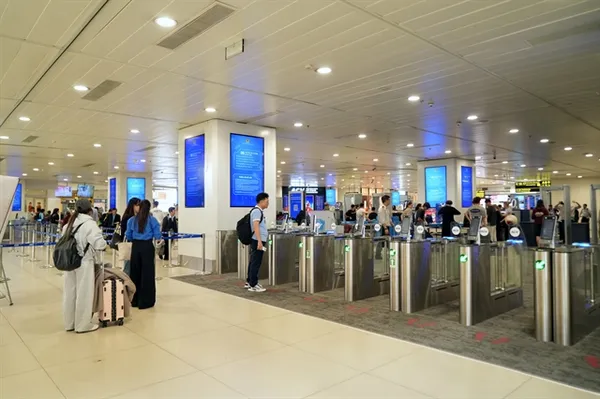 Politics & Law
Politics & Law

By Lê Hương *
The press plays a vital role in recording history and journalists are regarded as the writers of contemporary history. During the nation's sacred resistance wars, Vietnamese journalists, including the dedicated team from the Vietnam News Agency (VNA), were truly journalists-soldiers.
Fifty years after the end of the American War in Việt Nam, retired VNA journalists vividly recall each battle where they captured moments in history. They reflect on their heroic pasts as war reporters whose contributions played a key role in the final victory on April 30, 1975.
Many moments were captured by young VNA reporters who bravely joined army troops on the front lines from 1954 to 1975, especially during the Hồ Chí Minh Campaign in the spring of 1975.
“Before joining the VNA, I didn’t even know what it was. We were studying literature at Hà Nội University,” recalled former journalist Chu Chí Thành. “Literature students aimed for careers in the arts, but the VNA was in the information sector.”
During those years, the American war had expanded into the North, and the determined struggle of the Vietnamese people in the South had a profound impact. Young people, especially students, were eager to join the battlefield and contribute to the cause.
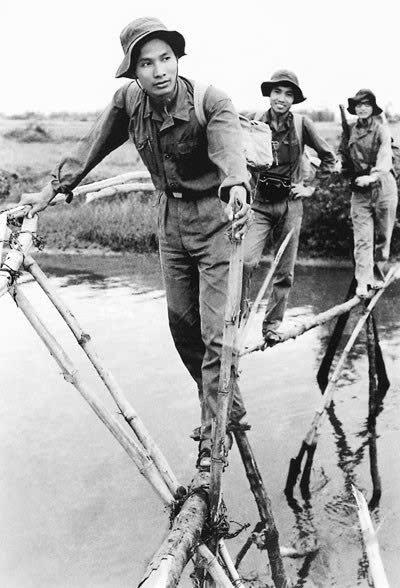 |
| Journalist Chu Chí Thành (first from the left) and Trần Mai Hưởng (second) on the way in their trip to McNamara Electronic Barrier in the central province of Quảng Trị. File Photo |
“Now, fifty years later, the emotions have settled, but I still remember those vibrant years of youth,” said former General Director of VNA, journalist Trần Mai Hưởng. “For our generation, going to the front lines was a normal thing.”
At the time, hardships and sacrifices were secondary to the mission. The priority was fulfilling the duty of a young journalist and everyone was eager and determined to do so.
Journalist Đinh Quang Thành, who has received over 30 awards for his photo collections, including a State Prize for his photo collection titled 'We Still March Forward Though the Enemy Destroyed', will never forget the intense years when the Americans bombed the North between 1964 and 1972.
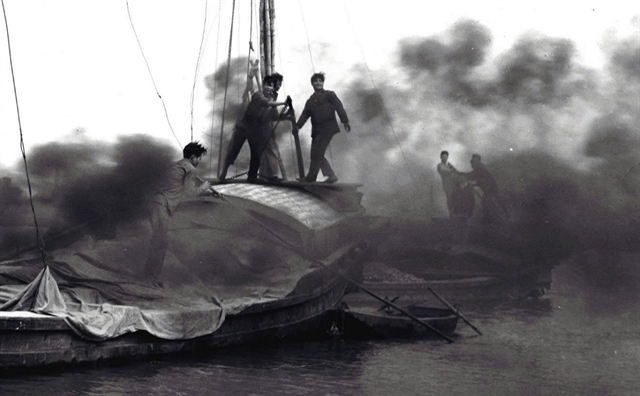 |
| A photo features people driving a boat carrying food from Hà Nam Ninh to No 4 Area despite fierce bombing in 1966 - part of a collection that helped bring journalist Đinh Quang Thành a State Prize in Literature and Arts. |
“At that time, there was only one road, Road No. 1, from Hà Nội to Lạng Sơn,” he recalled. “Whenever the enemy struck, we had to repair the damaged section to continue. There was no other way. We fought and fixed the road as we moved forward.”
Journalist Chu Chí Thành is famous for his photo collection capturing a moment when soldiers from both the North and South met during a prisoner exchange in Quảng Trị after the Paris Agreement in 1973.
For him, these images hold special significance, symbolising a longing for peace, reconciliation, national unification, and a deep humanitarian spirit.
“At the time, I had just come from the North and had never seen a Sài Gòn soldier,” he said. “They were portrayed as brutal and vicious. But after peace was achieved, I saw them working alongside liberation soldiers, even shaking hands with female fighters. It was a powerful moment of peace and hope.”
 |
| Journalist Đinh Quang Thành talks with Saigonese people on April 30, 1975. File Photo |
Final campaign
Each journalist of that era was also a soldier. Their paths through history were marked by numerous changes, but memories of participating in the Hồ Chí Minh Campaign remain deeply ingrained. When reminded, those memories flow out uncontrollably.
Journalists Đinh Quang Thành and Trần Mai Hưởng were among the fortunate few to enter Sài Gòn in late April 1975.
“When I went on the Hồ Chí Minh Campaign, I never thought about sacrifice,” Thành said. “I just focused on capturing photos for the press, both in Việt Nam and abroad.”
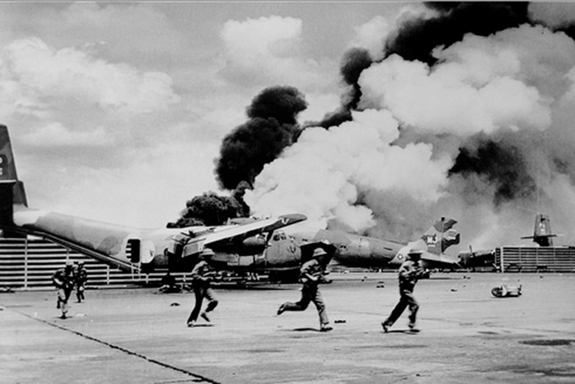 |
| A photo features soldiers in Division No 10 taking power at Tân Sơn Nhất Airport, which is in a photo collection titled 'Liberating Sài Gòn' by journalist Đinh Quang Thành. |
He followed the main attacking axis and captured powerful images, such as one where enemy soldiers were lying dead while Vietnamese troops crossed over their bodies. “I couldn’t stop to think, I had to keep shooting and running with the soldiers. I captured many vivid scenes, each one dynamic and impactful.”
Journalist Trần Mai Hưởng recalls the atmosphere on the morning of April 30, 1975.
“Though there was still fighting and gunfire, the people’s mood was joyous,” he said, his voice trembling with emotion. “I remember taking photos of people waving to soldiers, even as battles raged nearby.”
By the time they reached the Independence Palace, the first vehicles had already arrived and he took a photo of the one following closely behind. That image became a symbol of victory in 1975.
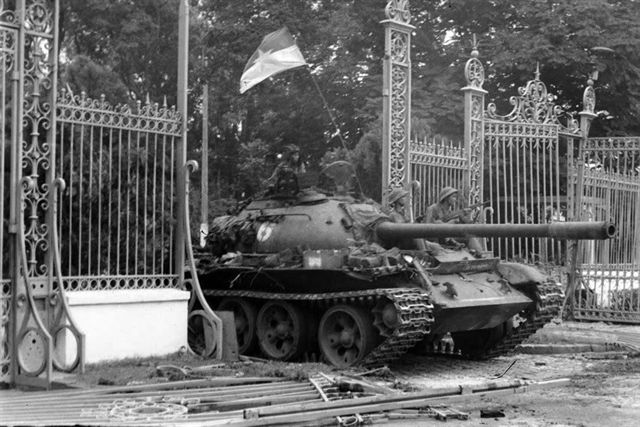 |
| The historic photo by journalist Trần Mai Hưởng capturing a tank of the Liberation Force attacking the Independence Palace. |
Professional pride
They take great pride in their generation’s contributions to the fight against the Americans.
“In reality, compared to my comrades, the soldiers and the youth volunteers, my contributions are small,” said Chu Chí Thành. “But the photos that won awards like the Hồ Chí Minh Award and the State Award recognise my dedication to capturing the truth. My true pride, though, comes from my family, my education and the soldiers I fought alongside. They instilled in me a deep sense of humanity.”
Hưởng believes that the war correspondents of VNA will always be a source of pride for their generation. During the war, VNA sent thousands of journalists to the front lines, from the French resistance to the fight against the Americans, and more than 260 VNA journalists made the ultimate sacrifice - the highest number among all media agencies in Việt Nam.
“To my knowledge, no country in the world has had so many journalists sacrifice their lives in a war,” Hưởng said.
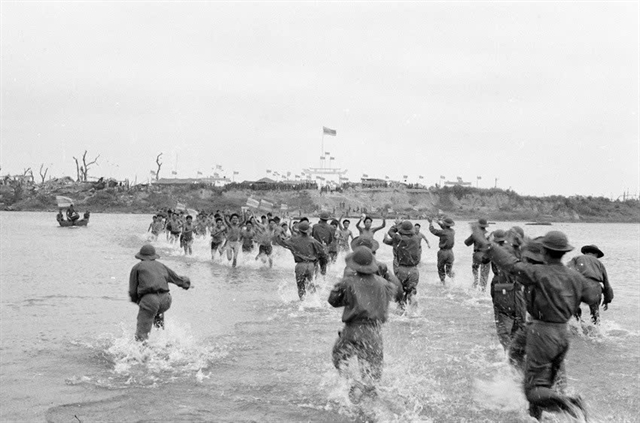 |
| A photo in the collection 'Exchanging prisoners on Thạch Hãn River - Quảng Trị Province' by journalist Chu Chí Thành, which won the State Prize in Literature and Arts in 2012. |
The past serves as a foundation for individual and collective development. “We have a glorious and beautiful past, and it will be a valuable legacy for today’s journalists,” Hưởng confirmed. “This legacy will help guide the agency in the new era and ensure that the press continues to meet the demands of modern society.”
Chu Chí Thành urged younger generations to honour the sacrifices made for the nation’s freedom. “In everything we do today - eating a bowl of rice, wearing beautiful clothes, walking these wide streets - we must remember those who are no longer with us,” he said. “Their sacrifices were not in vain.”
Fifty years later, these photos and articles are an invaluable national asset. Through immense hardships, crossing the line between life and death to ensure the flow of information, the journalists-soldiers of VNA on the information front fulfilled their noble mission. VNS
(with additional interviews by Minh Phương)
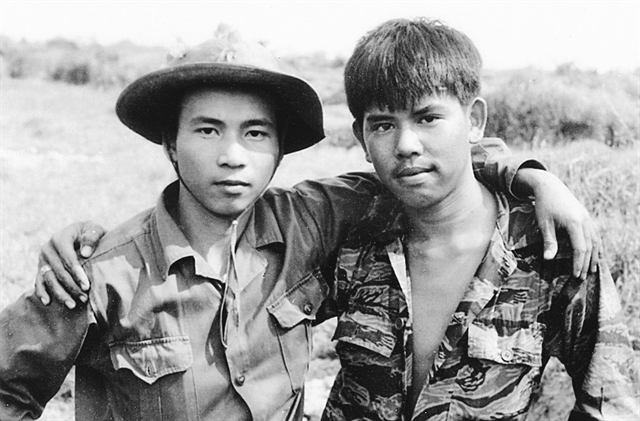 |
| Liberation Force' soldier Nguyễn Huy Tạo from Hà Nội (left) and Republic regime's soldier Bùi Trọng Nghĩa, from Sài Gòn hug each other in Quảng Trị Province in 1973. The photo is in the collection titled 'Two Soldiers', which earned Chu Chí Thành the Hồ Chí Minh Prize in Literature and Arts in 2022. VNA/VNS Photo Chu Chí Thành |




